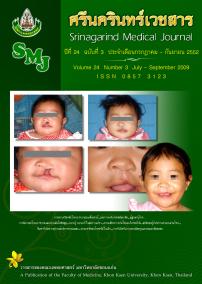ThaiScience
ThaiScience
SRINAGARIND MEDICAL JOURNAL
Volume 35, No. 05, Month SEPTEMBER, Year 2020, Pages 609 - 616
Attitudes towards the use of auxiliary labels among outpatients in a community hospital and 4 health promoting hospitals
Suyapat Konchoho, Narumol Jarernsiripornkul
Abstract Download PDF
Background and objectives: Rational Drug Use (RDU) project has been established to solve drug-related problems especially insufficient patients’ knowledge on medication use. Auxiliary labels has been launched to support all patients to get more access in drug labels and increase knowledge of their medications. Therefore, this study aimed to survey attitudes of outpatients towards the use of auxiliary labels and to assess factors related to the patients’ attitudes. Method: This cross-sectional study was conducted in a community hospital and four health promoting hospitals under the ministry of public health, Nakhon Ratchasima province. The study enrolled patients at the age of 18 and over who had received at least one out of ten drugs including allopurinol, amlodipine, colchicine, domperidone, enalapril, glipizide, ibuprofen, paracetamol, paracetamol mixed with orphenadrine, and simvastatin, and those had at least one month of drug use history. The sample was selected by purposive sampling in the total number of 1,000 respondents (100 for each drug). All patients received a questionnaire about the attitudes towards using auxiliary labels consisting of 14 items. Data was assessed using 5-point Likert scales and interpreted into 3 levels of the patients’ attitudes towards using auxiliary labels as poor, fair and good. Results: Of the total 1000 patients, 51.8% were females with an average age of 55.61 ± 12.86 years old. The patients expressed their attitudes towards use of auxiliary labels at a good level 35.5% (mean ± SD = 56.58 ± 3.40) and a fair level 64.5% (mean ± SD = 43.34 ± 3.53). The patients strongly agreed with the top 3 following statements about auxiliary labels: “Auxiliary labels are reliable information sources” (32.2%), “If you have any questions about drug use, auxiliary labels will be the first option that you choose to use” (30.3%), and “Auxiliary labels help you remember the names of the drugs you received” (26.9%). Patients strongly disagreed with the top 3 following statements about auxiliary labels: “There is no need to have an auxiliary label for every drug” (32.6%), “Auxiliary labels make you feel uncomfortable to inform healthcare professionals when having side effects” (28.2%), and “When reading auxiliary labels, you want to stop using the medicines” (26.4%). Regarding the multivariate analysis, the independent factors related to better attitudes towards using auxiliary labels including age (OR 0.450, p=0.005), careers (OR 0.474, p=0.005), higher income (OR 6.187, p=0.002) and number of drugs currently used (OR 0.177, p=0.002). Conclusion: Patients had good attitudes towards auxiliary labels and they were aware of the importance of auxiliary labels. Therefore, strategies to increase patients’ recognition about the importance of auxiliary labels should be promoted. Also, auxiliary labels in all drugs prescribed should be provided to patients to increase knowledge of their medications.
Keywords
attitudes auxiliary labels drug labels outpatientsSRINAGARIND MEDICAL JOURNAL
Published by : Faculty of Medicine, Khon Kaen University
Contributions welcome at : http://www.smj.ejnal.com/e-journal/journal/index.php
